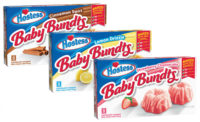On The Go... Out Of The Home
Snack producers and wholesale bakers search for new innovations in paperboard packaging that provide value, offer convenience and enhance brand identity among time-pressed consumers.
When it comes to paperboard packaging, bakery and snack producers are looking for enhanced graphics, higher gloss, easy-to-handle shapes and multiple sizes ranging from single-serve for convenience stores to super-sized packages for mass merchandisers and warehouse clubs.
But imagine having a convenience store right inside your pantry, says Tony Petrelli, vice president, marketing & business development for Caraustar Industries. Inc.
That’s what’s happening in today’s retail environment. More often than ever, companies are placing single-serve packages in display cartons so that families can save money by purchasing these items in bulk while providing the convenience of a grab-and-go product for their backpack-toting kids.
“What we are designing are a lot more of these tuck-top boxes where you get them home, and they’re almost like boxes near the checkout counter in the supermarket or at the C-store,” Petrelli notes. “They’re really a tray where you lift the lid and you create a display right in your pantry.”
To provide consumer value through packaging, snack manufacturers and wholesale bakers are searching for such attributes as shelf appeal, recloseability, durability and longer shelf life, adds Calvin Hill, director of global product development for rigid paper packaging at Sonoco.
“We do think that recloseability and portability are advantages to the paperboard package, but the real competitive advantage comes in innovation in shapes, sizes and new materials, and our ability to offer customized solutions to customers,” Hill explains.
In Sonoco’s case, he adds, composite cans are popular among snack producers because they’re portable, easy to open and simple to reclose, and they protect fragile snacks, such as crackers or potato crisps.
Cookie, cracker and salted snack producers also are asking for tapered cartons, gable tops, rounded corners and even milk cartons that are easier to hold, stack and even dispense of product, Petrelli says.
“From a structural standpoint, we are constantly evaluating how to make a product portable and easy to use by consumers,” he says. “We use the one-hand strategy. Is it a package that they can operate with one hand while they’re driving a car or holding a baby? Shape is so important when it comes to packaging.”
Many snack and baking companies also want traditional packaging with an innovative twist that provides extra value for the consumer. For the refrigerated dough market, consumers are familiar with spiral round cans that pop open when the label is peeled. Sonoco developed a “kit pack,” or a can with an extra container of frosting or sprinkles to decorate cookies or pastries.
“They’re looking for packaging attributes that reach out and touch the consumer,” Hill explains. “It’s not acceptable to just have the same package design forever. A lot more innovation is required.”
In many cases, innovation comes through high-impact graphics on extra-large paperboard cartons, which can create a billboard effect in the retail environment.
“Paperboard is probably the best packaging medium for promoting and communicating a product because you have that flat billboard and multiple printing techniques,” Petrelli says. “We’re being asked all of the time to use graphic enhancements to promote a product in categories where you haven’t seen it before.”
In the cookie, cracker and salted snack categories, he says, producers are asking for ultraviolet coatings, foil stamping and holograms that build the brand and can be used with television or movie tie-ins. Recently, Kraft Foods used holograms to tie in products with the Incredible Hulk.
“When we talk about packaging, it’s really about brand imaging,” Petrelli says. “We approach it as not just a single package itself, but also how does it sit in the retail environment. How is the consumer going to be using it? It’s all about shelf impact and about consumer convenience and use. Those are probably the biggest issues.”
To provide innovation, packaging companies must monitor global trends and product developments to find the latest in materials and packaging applications, Hill notes. In addition to more durable materials and food safety features, food companies are searching for packages that not only protect the product’s integrity, but also can be used as a vehicle to prepare the item.
To provide quick heating of on-the-go products, for instance, pizza and hot snack producers are providing portion-controlled meals using ovenable or microwaveable packaging. For instance, Toronto-based Molinaro is supplying 7-Eleven with personal pizzas that can be microwaved in a minute. Consumers simply pull the tab on the side of the box, tear it off and tear open the perforated lid before zapping. After sitting for another minute to thoroughly heat the product, the pizza is ready for instant consumption.
For packaging companies, the challenge is not only innovation, but also speed to market. Snack and bakery producers want to reduce the time for product development so that they’re first to hit the market with a new product concept.
“The challenge to drive toward faster commercialization has increased significantly over the past several years,” Hill says. “In this environment we have to be more creative and constantly reduce technical complexity. Our customers’ success depends on speed and accuracy.”





